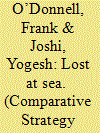|
|
|
Sort Order |
|
|
|
Items / Page
|
|
|
|
|
|
|
| Srl | Item |
| 1 |
ID:
135840


|
|
|
|
|
| Summary/Abstract |
We construct an analysis framework for nuclear force structure where the ends are deterrence objectives, the ways are viable targeting strategies, and the means are nuclear forces. Deterring adversaries requires both capability and will that convinces them not to act. A country's will is perceived as credible only if the war plans and targeting strategies are consistent with a nuclear power's principles, such as the Just War Doctrine. The United States currently applies a counter-force targeting strategy; however, hardening, mobility, deceptions, and defensive systems continue to challenge the ability to target another's nuclear weapons. Alternative strategies, such as counter-economic (energy, transportation, financial center, or communications) and counter-leadership may be feasible. However, with fewer nuclear weapons, fewer targeting strategies are viable
|
|
|
|
|
|
|
|
|
|
|
|
|
|
|
|
| 2 |
ID:
135838


|
|
|
|
|
| Summary/Abstract |
The United States’ attempt to deter chemical weapons use by the Syrian government failed largely due to the former's lack of credibility. Having seen its implicit deterrent threats ignored in spring and summer, 2013, the United States scrambled to restore them by threatening to use force explicitly, only to find that its credibility was exhausted. Syria's subsequent pledge to give up its chemical weapons, popularly explained as a response to renewed U.S. threats, likely reflected a strategic environment changed more by developments in Syria than any application of U.S. deterrent strategy.
|
|
|
|
|
|
|
|
|
|
|
|
|
|
|
|
| 3 |
ID:
135839


|
|
|
|
|
| Summary/Abstract |
The Global Nuclear Detection Architecture is a worldwide system for detecting illicit radiological or nuclear (R/N) material and R/N weapons. The technical and nontechnical detection capabilities of the architecture can contribute to the deterrence of nuclear terrorism by increasing the risks and costs of mounting an R/N attack. Risks include the danger of one or more encounters with elements of the architecture, uncertainties about the locations and other characteristics of detection capabilities, discovery upon encounter with detection capabilities, and attack failure upon discovery. Among the costs are the added manpower, money, materiel, time, and operational difficulties entailed by attempts to evade or defeat detection capabilities. The deterrent effect of the detection architecture—part of a broader effort to counter nuclear terrorism—warrants greater attention and emphasis.
|
|
|
|
|
|
|
|
|
|
|
|
|
|
|
|
| 4 |
ID:
135842


|
|
|
|
|
| Summary/Abstract |
India's first nuclear-armed ballistic missile submarine, the INS Arihant, signifies a milestone in its rise to power. However, its development and supportive strategic discourse reveal the absence of an Indian grand strategy. India urgently needs a grand strategy to direct its defense policy.
|
|
|
|
|
|
|
|
|
|
|
|
|
|
|
|
|
|
|
|
|